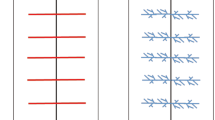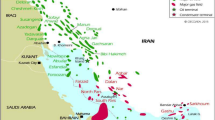Abstract
Horizontal wells and hydraulic fracturing made a significant contribution to the US unconventional oil and gas production. However, due to complex fracture networks forecasting oil and gas production is a challenging task. This paper derives characteristic distribution of block patterns and fractures that are located between the blocks in traditional and unconventional reservoirs. By analyzing historical well production data on tens fields in different basins using distribution of initial and cumulative production and decline curve analysis of thousands wells from 1960 to 2019 we show that the Hyperbolic model, Pareto and Arps Laws can apply on the well-by-well production data on traditional and unconventional fields including shale and tight reservoirs. Physical and mathematical modeling and studies conducted in many oil and gas fields show that multi-scale rock fractures divide productive rocks into blocks of various sizes, which are complex self-similar fractal structures, and their behavior is described by a power law distribution and a general universal Pareto law. The generator of power law distribution and Pareto’s Law is an algorithm for cascading splitting of the continuum. It was found that the linear dimensions of different-scale blocks in fractured reservoirs asymptotically approach the value of the Golden Sect. (1.618). Based on this law has been developed fractal model of fractured reservoir. It includes several hierarchical levels of matrix blocks and fractures, sometimes ten and more. In the proposed model, not only the sizes of the blocks are in the ratio of 1.618, and permeability of the fractures changes in the ratio of 1.618, which allows to reproduce the daily and cumulative oil and gas well production according to power law distribution and Pareto’s law. The proposed model not only contributes to a more accurate mathematical description of the development of fractured oil and gas reservoirs in hydrodynamic modeling, but also allows us to explain in a new way the appearance of ring structures and vortex spiral objects in the earth’s crust, the formation of which is still debatable. Using of the special developed AVP program allows you to significantly improve the accuracy of hydrodynamic calculations of reservoir development and obtain all three types of Decline Curve wells in accordance with the Arps law.
Access this chapter
Tax calculation will be finalised at checkout
Purchases are for personal use only
Similar content being viewed by others
References
Petukhov, A.V.: Theory and Methodology of Structural and Spatial Zoning Study in Fractured Oil and Gas Reservoirs. Ukhta State Technical University, Ukhta (2002)
Petukhov, A.V., Shelepov, I.V., Petukhov, A.A., Kuklin, A.I.: Development of a mathematical model of complex reservoirs containing unconventional oil and gas resources. J. Gas Industry 676, 64–70 (2012)
Petukhov, A.V., Egorov, S.I., Oppermann, R., Karyakov, A.N.: New Technolgies of development of Austin chalk and Buda low-porous carbonate reservoirs in south Texas. In: Technical report, International Conference on Hard-to-Recover Resources and Unconventional Sources of Hydrocarbons. Problems, Possibilities, Estimates. VNIGRI, St. Petersburg, Russia (2015)
Petukhov, A.V., Kuklin, A.I., Petukhov, A.A., Vasquez Cardenas, L.C., Roschin, P.V.: Origins and integrated exploration of sweet spots in carbonate and shale oil-gas bearing reservoirs of the timan-pechora basin. In: SPE/EAGE European Unconventional Resources Conference and Exhibition. Society of Petroleum Engineers (2014). https://doi.org/10.2118/167712-MS
Petukhov, A.V.: The role of Hypogenic karst in formation of carbonate reservoirs and development of oil deposits. In: AAPG Middle East Region GTW on Regional Variations in Charge Systems and their Impact on Petroleum Fluid Properties in Exploration, AAPG Online Journal for E&P Geoscientists (2019). https://doi.org/10.1306/42361Petukhov2019
Petukhov, A.V., Egorov, S.I., Karyakov, A.N., Oppermann, R., Petukhov, A.A.: Using phenomenology, holistic models and new technologies to Optimise the development of oil and gas reservoirs. In: 7th EAGE Saint Petersburg International Conference and Exhibition (2016). https://doi.org/10.3997/2214-4609.201600181
Petukhov, A.V., Dolgiy, I.E., Kozlov, A.V., Petukhov, A.A.: Features of hydrodynamic modeling of deposits in fractured carbonate reservoirs of the Yurubcheno-Tokhomsky oil and gas accumulation zone. J. Notes of the Mining Institute 200, 242–248 (2013)
Petukhov, A.V., Shelepov, I.V., Petukhov, A.A., Kuklin, A.I.: Power law and self-similarity principle in the study of fractured oil and gas reservoirs and hydrodynamic modeling of the development process. J. Neftegazovaya Geologiya. Theory Practice. 7(2). http://www.ngtp.ru/rub/3/33_2012.pdf (2012)
Petukhov, A.V., Nikitin, M.N., Petukhov, A.A., Kuklin, A.I.: Structural features of non-Newtonian oils and reservoir rocks containing them. In: International Seminar Non-Newtonian Systems in the Oil and Gas Industry, pp. 31–40. Ukhta State Technical University, Ukhta (2012)
Petukhov, A.V.: Discrete irregular cellular models for simulating the development of fractured reservoirs. Patent WO 2016/011064, G06G7/48, pp. 45 (2016)
Author information
Authors and Affiliations
Editor information
Editors and Affiliations
Rights and permissions
Copyright information
© 2022 The Author(s), under exclusive license to Springer Nature Switzerland AG
About this paper
Cite this paper
Petukhov, A.V. (2022). The Fractal Model of Fractured Reservoirs Based on Pareto Distribution and Integrated Investigations. In: Indeitsev, D.A., Krivtsov, A.M. (eds) Advanced Problem in Mechanics II. APM 2020. Lecture Notes in Mechanical Engineering. Springer, Cham. https://doi.org/10.1007/978-3-030-92144-6_41
Download citation
DOI: https://doi.org/10.1007/978-3-030-92144-6_41
Published:
Publisher Name: Springer, Cham
Print ISBN: 978-3-030-92143-9
Online ISBN: 978-3-030-92144-6
eBook Packages: EngineeringEngineering (R0)




